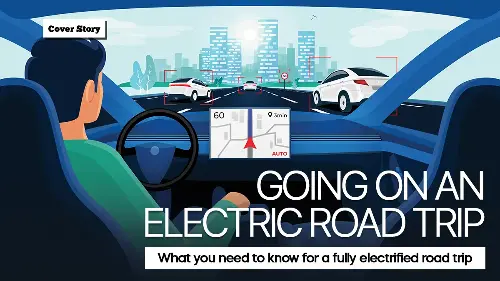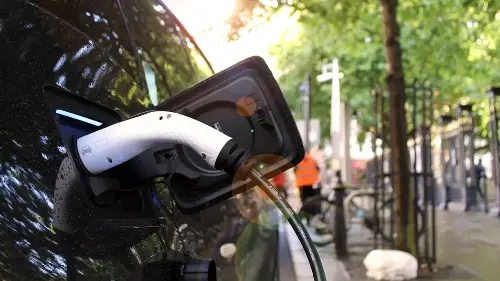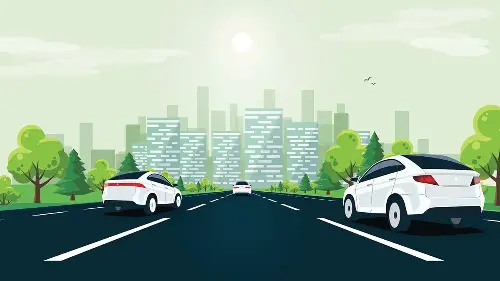
What you need to know for a fully electrified road trip
Electric vehicles (EVs) have surged in popularity over the past year. Brands like BYD, Tesla, Hyundai, and VinFast have introduced fully electric models into the country, making EVs a familiar sight on Philippine roads. For many Filipinos, EVs have become part of their daily commute.
EVs are particularly well-suited for city driving, thanks to their energy regeneration capabilities. They are also significantly cheaper to operate, as charging costs are generally lower than refueling with gasoline.
However, what makes EVs great for urban environments does not necessarily translate to highway driving. EVs tend to consume more energy on highways since they must continuously maintain speed. Additionally, highway travel provides fewer opportunities for regenerative braking, as there is typically less stop-and-go traffic to facilitate energy recovery.
While most EVs on the market today have enough range to reach iconic tourist destinations from Metro Manila, range anxiety remains a concern due to the limited charging infrastructure on highways. To ensure a hassle-free road trip, planning is essential. Here’s what you need to consider when embarking on an EV road trip.

Know your Car
As with any vehicle, understanding your EV’s specifications is crucial before heading out on a road trip. For internal combustion engine (ICE) cars, pre-trip checks include monitoring oil levels, fuel, and tire pressure. With EVs, the preparation process is different but just as important. You need to be aware of your battery health, capacity, weight limits, and charger compatibility.
Charging Standards: Compatibility Matters
Unlike gasoline refueling, EV charging connectors are not standardized globally — or even domestically. The most common charging standards include:
- Type 1 and CCS Type 1 – Older North American and Japanese models
- GBT – China’s EV charging standard
- Type 2 and CCS2 – European standard, the most common in the Philippines
- Tesla Supercharger Port – Mainly in North America
- CHAdeMO DC Standard – Used in older Japanese models
- NACS (North American Charging Standard) – Tesla’s new universal standard
In the Philippines, Type 2 and CCS2 ports are the most widely available at public charging stations. If your EV uses a different connector, carrying a converter is crucial. However, keep in mind that many service stations with charging facilities do not allow charging with an adapter. Always check in advance to avoid unexpected issues.
Charging Speed and Efficiency
Beyond connector compatibility, understanding your EV’s charging speed is essential. Most EVs support 7kW AC charging, but premium models can handle up to 22kW AC.
For faster charging, DC chargers are the best option. Many DC chargers in the Philippines provide up to 180kW, but this drops to 90kW when shared between two vehicles. Some high-end EVs can accept up to 300kW, so knowing your car’s maximum charging capacity helps you pick the most efficient station.
Real-World Range vs. Advertised Range
EVs rarely achieve their advertised range due to external factors such as driving style, road conditions, and weather. To estimate your car’s actual range, monitor its daily energy consumption under normal conditions. This will help you plan for charging stops more accurately and prevent unexpected battery depletion.

Plan Ahead
The key to a smooth EV road trip is careful planning. Since the charging infrastructure is still developing, identifying charging points along your route is critical.
Use Route Planning Apps
Fortunately, several apps can simplify the process. Two of the most useful are:
- PlugShare – A crowd-sourced app that maps out available chargers and provides real-time user reports. Being community-driven, some locations on the map may not be updated in real-time, meaning that they can be under repair, broken, or in use unless a person reports the same. Despite its weaknesses, it remains a very useful app to know where you can charge on your route and plan accordingly.
- A Better Route Planner (ABRP) – A smart navigation tool that calculates routes based on your EV’s battery range and available charging stations. It takes a look at all possible routes and adjusts to incorporate charging stops. Once you have your route, you can save and access it once you’re ready to start your trip.
Download Essential Charging Apps
Most charging stations in the Philippines require proprietary apps to initiate charging. Key apps include Evro, Solarius, and other provider-specific platforms. Make sure you have these installed and set up before your trip.
Consider Load and Weight Limits
Luggage and passenger weight impact EV efficiency. The heavier your vehicle, the more energy it consumes. Be mindful of your EV’s maximum load capacity, especially if you plan on bringing home souvenirs from your destination.
Know the Road and Route
Understanding road conditions is just as important as knowing your car’s specifications. After all, no one wants to hit a patch of rough road and suffer a bumpy ride.
Inclines and Energy Consumption
Elevation changes significantly affect an EV’s energy consumption. Inclines require more power, as gravity works against the motor. Steep uphill drives can use twice the energy compared to cruising on a flat highway. Before tackling a long uphill stretch, consider charging beforehand to avoid running out of battery mid-climb.
Maximizing Regenerative Braking
One of the key advantages of EVs is regenerative braking, which converts kinetic energy back into battery power when slowing down. While this works exceptionally well in city traffic, you can still optimize it on a road trip by adjusting your driving habits. Utilizing regenerative braking on long descents or when slowing for turns can help stretch your range significantly.
Always Have Backup Charging Plans
EV charging infrastructure, while improving, still has limitations. Chargers may be occupied, out of service, or located in inconvenient areas. Having multiple backup plans ensures you’re never stranded.
Prepare Alternative Charging Options
- Identify multiple charging stations along your route.
- Have an exit strategy in case of low battery warnings.
- Carry a portable EV charger, ensuring it has proper grounding before departure.
- Keep emergency contact numbers handy in case of unexpected breakdowns.
EV Road Trips in the Philippines: The Future is Bright
While the Philippines is still expanding its EV charging network, long-distance travel is becoming more feasible. The key to a successful EV road trip is careful planning and flexibility. With the right mindset and preparation, you can enjoy a smooth, stress-free, and environmentally friendly journey.
EV road trips may require more thought than traditional fuel-powered journeys, but the benefits — lower costs, a quieter ride, and zero emissions — make it worth the effort.
With the proper planning, your electrified adventure awaits. Have fun and happy trails!
Final Tips for a Seamless EV Road Trip
- Start with a full charge – It may seem obvious, but beginning your trip with a 100% charged battery maximizes range.
- Check weather conditions – Cold or extreme heat can affect battery performance.
- Drive efficiently – Avoid sudden acceleration and high speeds, as they deplete the battery faster.
- Monitor energy use – Keep an eye on your energy consumption to avoid unnecessary surprises.
- Leverage rest stops – Use charging breaks wisely by planning meals or stretching while your car charges.
By following these guidelines, you’ll be well-equipped to take on an electrified road trip with confidence and ease!
Words by Gabriel John Pe
Also published in GADGETS MAGAZINE Volume 25 No. 8 Issue.
